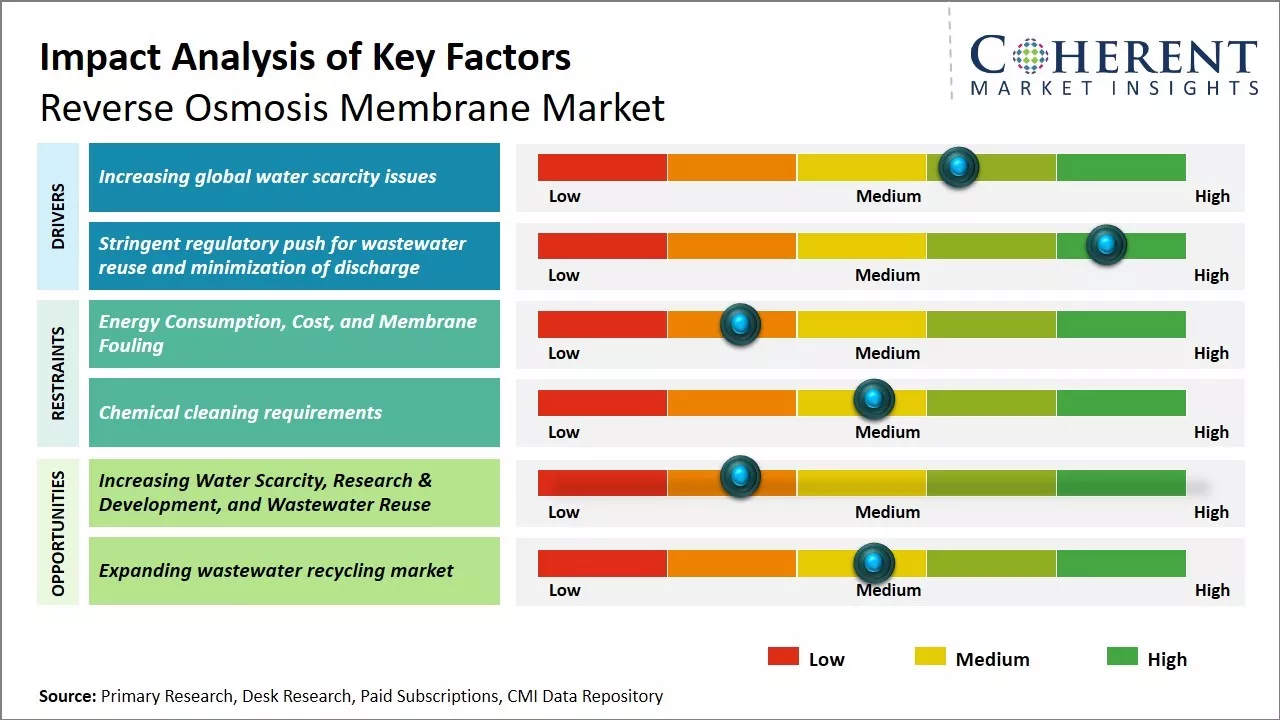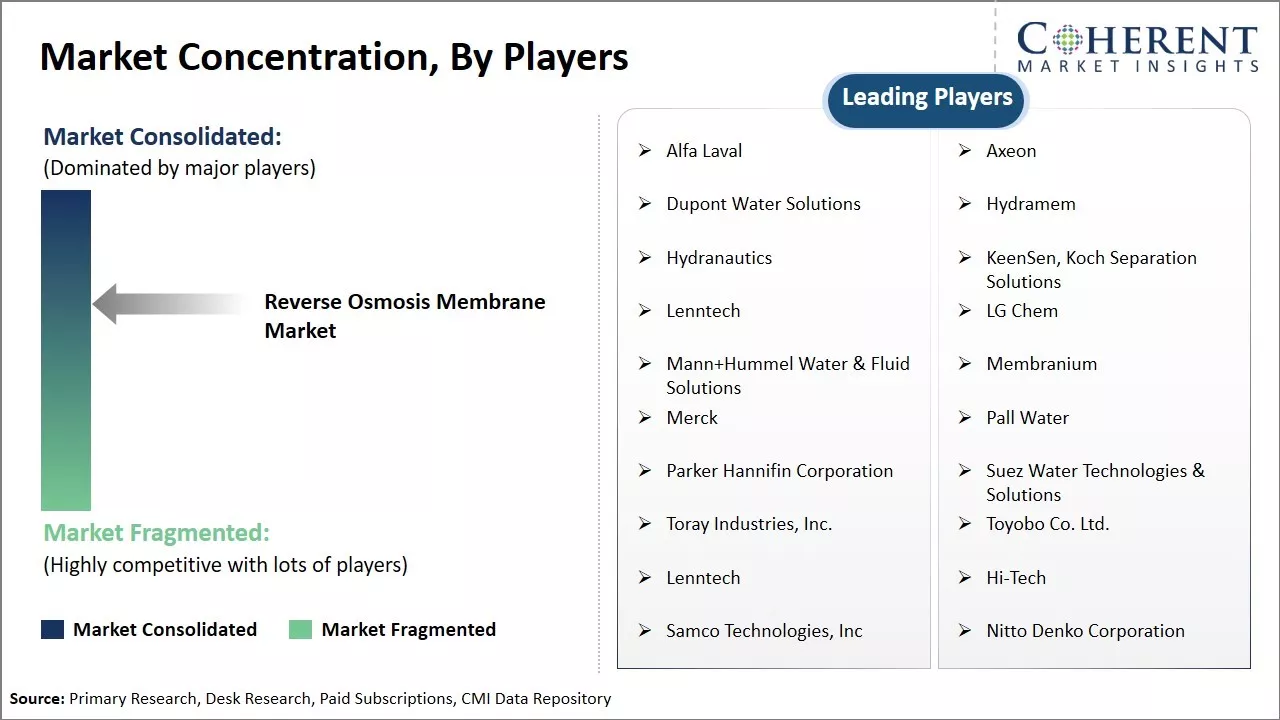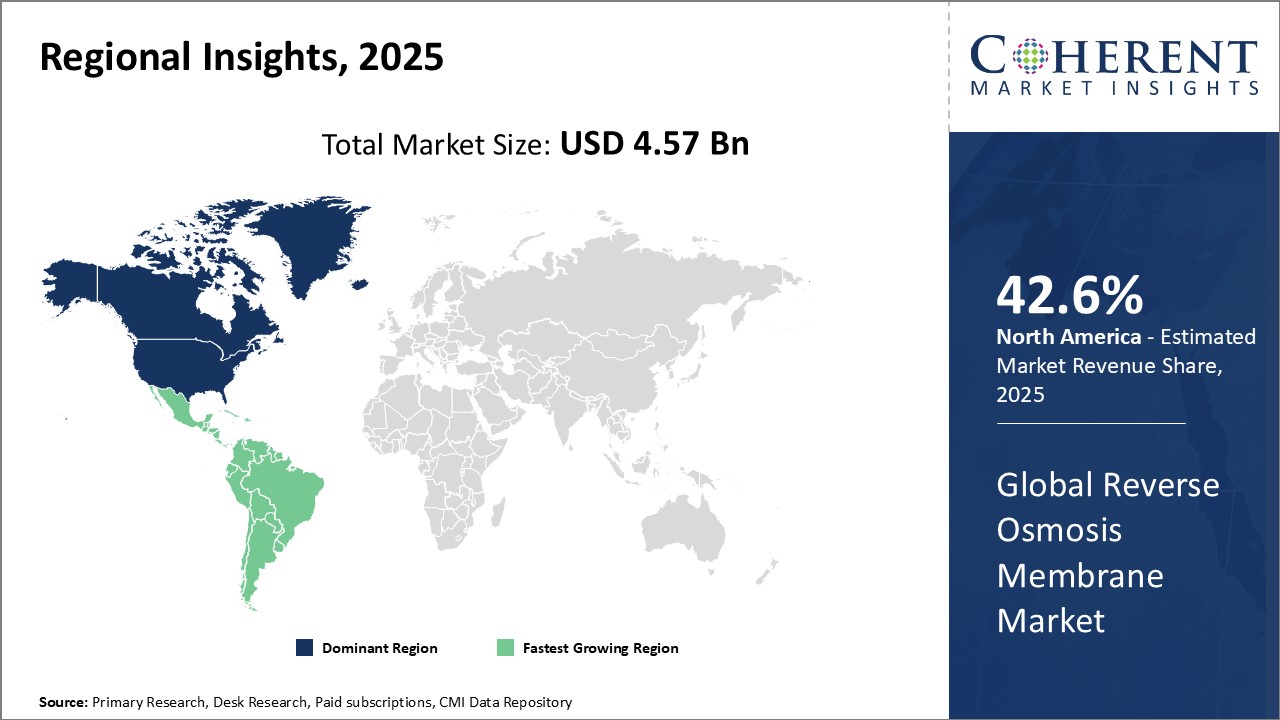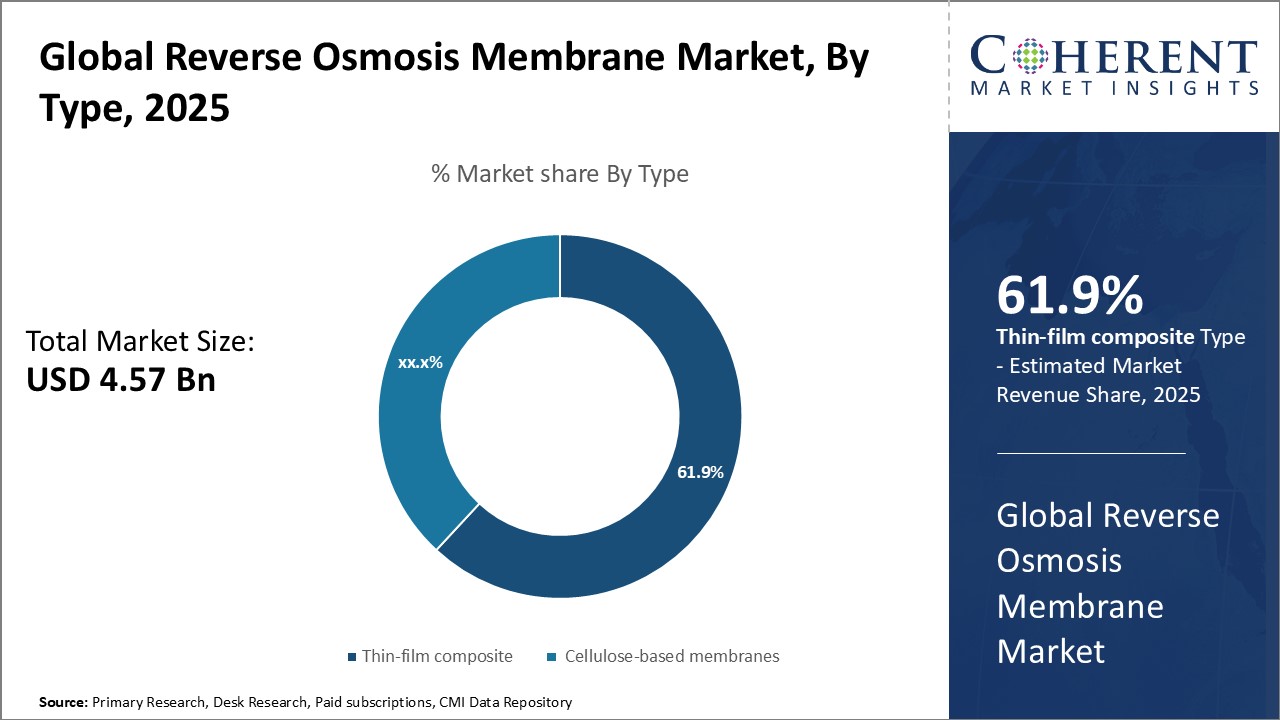Global Reverse Osmosis Membrane Market Size and Forecast 2025-2032
Global Reverse Osmosis Membrane Market is estimated to be valued at USD 4.57 Billion in 2025 and is expected to reach USD 9.08 Billion by 2032, exhibiting a compound annual growth rate (CAGR) of 10.3% from 2025 to 2032.
Key Takeaways of the Global Reverse Osmosis Membrane Market
- In terms of type, thin-film composite segment is estimated to contribute the 61. 9% share of the market in 2025.
- In terms of filter module, the spiral wound segment is estimated to contribute 38. 3% share of the market in 2025 owing to its compact design and simple scalability.
- In terms of application, wastewater treatment & reuse segment is estimated to contribute 40. 3% share of the market in 2025.
- North America has established itself as the largest regional market for reverse osmosis membranes globally, with an estimated 42. 6% share in 2025.
Market Overview
The demand for reverse osmosis membranes is expected to grow steadily during the forecast period. Rising consumption of treated water for various end-use industries, such as municipal, industrial, and others, is expected to drive the market growth.
In municipal applications, growing concerns regarding clean drinking water and wastewater recycling are anticipated to boost the installation of desalination plants using reverse osmosis membrane technology. Strict regulations regarding wastewater discharge from industrial facilities are likely to drive the market growth. The emergence of innovative low-pressure reverse osmosis membranes with improved flux rates and lower energy requirements compared to conventional membranes is expected to provide new growth opportunities over the next years.

To learn more about this report, Download Free Sample
Current Events and their Impacts
|
Current Events |
Description and its Impact |
|
Government Funding and Policy Initiatives
|
|
|
Regional Regulatory Shifts and Industrial Demand
|
|
Uncover macros and micros vetted on 75+ parameters: Get instant access to report
Impact of AI on the Global Reverse Osmosis Membrane Market
Artificial intelligence is revolutionizing the global reverse osmosis membrane market by enhancing operational efficiency, reducing costs, and extending equipment longevity.
- AI is revolutionizing RO systems by optimizing operations, dynamically adjusting parameters like flow and pressure to cut energy and chemical use. For instance, AI models have enabled extended operation without membrane cleaning, reducing costs.
- AI also drives predictive maintenance and fouling control, with algorithms analyzing data to forecast membrane fouling. This allows for preemptive cleaning, extending membrane lifespans, and cutting chemical use, as seen with platforms like Hubgrade's Smart Membranes.
- Companies like Veolia, with their Hubgrade Smart Membranes solution, demonstrate AI's tangible benefits, leading to significant reductions in energy consumption, unscheduled downtime, and improved water output stability for industrial clients.
Market Trends
Increasing Global Water Scarcity Issues
Increasing global water scarcity is a primary catalyst for the reverse osmosis membrane market. Millions worldwide lack access to safe drinking water due to population growth, urbanization, and climate change. The United Nations predicts 1.8 billion people will face absolute water scarcity by 2025, pushing countries to prioritize wastewater treatment and reuse. RO technology offers a vital solution for non-potable applications and is crucial for desalination in water-scarce regions.
Stringent Regulatory Push for Wastewater Reuse and Minimization of Discharge
Stricter environmental discharge regulations and policy incentives for water reuse and recycling are significant drivers for RO membrane technology. These regulatory pushes are accelerating the adoption of RO membranes in both municipal and industrial wastewater treatment, as organizations look to minimize their environmental impact and maximize water efficiency.
Market Concentration and Competitive Landscape

To learn more about this report, Download Free Sample
M arket Opportunity: Increasing Water Scarcity, Research & Development, and Wastewater Reuse
Increasing global freshwater scarcity and depletion of existing resources are creating significant opportunities for the reverse osmosis membrane market, pushing continuous research and development to improve membrane properties, reduce energy usage, and lower costs.
For instance, recent advancements include the development of graphene oxide membranes that offer superior water flux and contaminant rejection, alongside smart monitoring and control systems that optimize RO plant performance and predict fouling in real-time, making water reuse more efficient and economical.
Analyst View
- The reverse osmosis (RO) market is a lucrative and rapidly expanding sector, primarily driven by the escalating global demand for clean water and water treatment in various industries. Asia Pacific leads this growth due to population and industrialization, with North America also seeing strong momentum from regulatory mandates.
- Despite its potential, the RO market faces significant hurdles like high capital expenditure for plant setup and the ongoing issue of membrane fouling, which increases operational costs.
- Exciting opportunities lie in new application areas such as seawater desalination and the food and beverage industry, promising substantial demand for membrane suppliers. Leading companies should strategically expand their presence, particularly in water-stressed regions like the Middle East, South Asia, and Africa.
Macro-economic Factors Impacting the Market
- Rising global population and urbanization, coupled with stringent government regulations and public health policies like World Health Organisation (WHO) guidelines and Environmental Protection Agency standards, are intensifying water scarcity and driving significant demand for RO technology in nations like India, China, and the U.S.
- Climate change is making RO critical for drought-prone regions, with areas like California increasingly relying on large-scale RO desalination plants to ensure water security and build climate resilience.
Global Reverse Osmosis Membrane Market Insights, by Type
In terms of type, the thin-film composite segment is estimated to contribute 61.9% share of the market in 2025, owing to its technological advantages over other membrane types. Thin-film composite membranes offer superior permeability and selectivity as compared to traditional cellulose-based membranes.
Their thin polymeric film and ultra-porous support layer structure allow for high flow rates while effectively blocking dissolved salts and other contaminants. Additionally, thin-film composite membranes are more durable and resistant to fouling than cellulose membranes, reducing maintenance and replacement costs.
Global Reverse Osmosis Membrane Market Insights, by Filter Module
In terms of filter module, the spiral wound segment is estimated to contribute 38.3% share of the market, owing to its compact design and simple scalability. Spiral wound modules offer the highest available membrane area per volume through their rolled configuration of membrane sheets and feed spacers.
This maximizes space efficiency and significantly reduces capital costs for larger desalination and water treatment plants. Spiral wound modules can also be easily scaled up by adding more membrane leafs and feed channels to the rolls. Spiral wound modules also provide stable, long-term performance through their durable closed-loop piping network. Their market dominance is expected to continue as water scarcity increases the need for large-scale, economical reverse osmosis solutions.
According to the United Nations, over 2 billion people globally live in countries experiencing high water stress, and by 2025, an estimated 50% of the world’s population will live in water-stressed areas. This growing scarcity is driving demand for efficient water treatment technologies such as RO membranes.
Global Reverse Osmosis Membrane Market Insights by Application
In terms of application, the wastewater treatment & reuse segment is estimated to contribute 40.3% share of the market, due to the growing recognition and implementation of water recycling initiatives globally. Reverse osmosis plays a critical role in advanced wastewater treatment by removing dissolved salts, heavy metals, and other impurities to potable or near-potable standards. With freshwater scarcity on the rise, many industrial facilities and municipalities are adopting water reuse and reclamation practices to supplement their process water needs.
Reverse osmosis allows for multiple stages of wastewater treatment and purification to achieve stringent quality criteria for non-potable reuse in cooling towers, boilers, and industrial processes. Rising environmental regulations regarding water discharge quality are also propelling the use of reverse osmosis in industrial wastewater treatment applications. As water scarcity concerns intensify worldwide, wastewater reclamation through reverse osmosis membrane technology is expected to be a major driver of segment growth.
Regional Insights

To learn more about this report, Download Free Sample
North America Reverse Osmosis Membranes Market Trends
North America has established itself as the largest regional market for reverse osmosis membranes globally, with an estimated 42.6% share in 2025. The region enjoys a strong presence of major membrane manufacturers like DuPont Water Solutions, SUEZ Water Technologies & Solutions, Koch Separation Solutions, Hydranautics, and Toray Industries. These companies, alongside others like LG Chem and AXEON Water Technologies, cater to robust demand from industrial and municipal sectors, offering a wide range of RO membranes for diverse applications, from large-scale desalination to industrial process water treatment.
Moreover, countries like the U.S. is one of the leading exporters of desalinated water to Latin America and the Caribbean, augmenting regional requirements. With capacity expansions underway, membrane suppliers are geographically well-positioned to cater to North American customers.
Asia Pacific Reverse Osmosis Membranes Industry Trends and Growth Forecast
The Asia Pacific region has emerged as the fastest growing market for reverse osmosis membranes in recent years. This growth is driven by intense demand for sustainable water supplies due to rapid industrialization and population expansion. Countries like China and India are at the forefront, heavily investing in large-scale RO desalination plants, such as China's aim for 3.5 million cubic meters daily desalination capacity by 2025 and India's upcoming Perur Desalination Plant with 400 MLD capacity.
Countries like China, India, and Saudi Arabia are at the forefront in terms of installing large-scale desalination plants based on reverse osmosis technology. Meanwhile, burgeoning water treatment activity across industrial units such as power, chemical and food & beverage has stimulated membrane imports. With supportive government initiatives and growing awareness, the Asia Pacific reverse osmosis membrane landscape is expected to flourish further in the coming years.
Europe Reverse Osmosis Membranes Market Analysis
Europe Reverse Osmosis Membranes Market is growing strongly, driven by strict water quality rules and water scarcity. This boosts demand for RO in municipal and industrial uses. Despite energy and fouling challenges, R&D in efficient membranes and the growing focus on water reuse are creating significant opportunities. Despite ongoing challenges such as high energy consumption and membrane fouling, continuous research and development into more energy-efficient and anti-fouling membranes, coupled with a rising focus on water reuse and recycling, is creating substantial new market opportunities. Key countries like Germany are showing strong growth potential in this evolving market landscape.
India Reverse Osmosis Membranes Market Trends
India Reverse Osmosis Membranes Market is experiencing strong growth, fueled by rising clean water demand from residential, industrial, and municipal sectors. Key drivers include urbanization, water scarcity, and health awareness. Government initiatives and tech advancements further boost adoption, making India a significant RO market despite investment and brine disposal challenges.
Market Report Scope
Global Reverse Osmosis Membrane Market Report Coverage
| Report Coverage | Details | ||
|---|---|---|---|
| Base Year: | 2024 | Market Size in 2025: | USD 4.57 Bn |
| Historical Data for: | 2020 To 2024 | Forecast Period: | 2025 To 2032 |
| Forecast Period 2025 to 2032 CAGR: | 10.3% | 2032 Value Projection: | USD 9.08 Bn |
| Geographies covered: |
|
||
| Segments covered: |
|
||
| Companies covered: |
Alfa Laval, Axeon, Dupont Water Solutions, Hydramem, Hydranautics, KeenSen, Koch Separation Solutions, Lenntech, LG Chem, Mann+Hummel Water & Fluid Solutions, Membranium, Merck, Pall Water, Parker Hannifin Corporation, Suez Water Technologies & Solutions, Toray Industries, Inc., Toyobo Co. Ltd., Lenntech, Hi-Tech, Samco Technologies, Inc, and Nitto Denko Corporation |
||
| Growth Drivers: |
|
||
| Restraints & Challenges: |
|
||
Uncover macros and micros vetted on 75+ parameters: Get instant access to report
Global Reverse Osmosis Membrane Industry News
- In May 2025, LG Water Solutions, a division of LG Chem, announced the product release of its new NF9 nanofiltration membrane.
- On January 21, 2025, Osmoflo and Aqua Membranes entered into a partnership to introduce 3D Printed Spacer Technology Solutions in water-scarce regions.
- In March 2024, Toray Industries, Inc. developed a highly durable reverse osmosis (RO) membrane.
- In April 2024, Veolia Water Technologies and Alkhorayef Group formed a partnership to address the growing demand for advanced water solutions in Saudi Arabia. This collaboration aims to establish a Reverse Osmosis (RO) membrane production facility and technical center in the Kingdom, expected to begin operations in 2026, combining Veolia's expertise with Alkhorayef Group's local knowledge.
- In December 2023, Hydranautics, part of the Nitto Group, launched a new energy-efficient reverse osmosis membrane specifically designed for industrial water treatment applications.
Market Segmentation
- Type Insights (Revenue, USD Bn, 2020 - 2032)
- Thin-film composite
- Cellulose-based membranes
- Filter Module Insights (Revenue, USD Bn, 2020 - 2032)
- Spiral Wound
- Hollow Fiber
- Tubular
- Plate and Frame
- Application Insights (Revenue, USD Bn, 2020 - 2032)
- Desalination
- Utility water treatment
- Wastewater treatment & reuse
- Process water
- End Use Insights (Revenue, USD Bn, 2020 - 2032)
- Water & wastewater treatment
- Industrial Processing
- Regional Insights (Revenue, USD Bn, 2020 - 2032)
- North America
- U.S.
- Canada
- Latin America
- Brazil
- Argentina
- Mexico
- Rest of Latin America
- Europe
- Germany
- U.K.
- Spain
- France
- Italy
- Russia
- Rest of Europe
- Asia Pacific
- China
- India
- Japan
- Australia
- South Korea
- ASEAN
- Rest of Asia Pacific
- Middle East & Africa
- GCC Countries
- Israel
- Rest of Middle East & Africa
- Key Players Insights
- Alfa Laval
- Axeon
- Dupont Water Solutions
- Hydramem
- Hydranautics
- KeenSen, Koch Separation Solutions
- Lenntech
- LG Chem
- Mann+Hummel Water & Fluid Solutions
- Membranium
- Merck
- Pall Water
- Parker Hannifin Corporation
- Suez Water Technologies & Solutions
- Toray Industries, Inc.
- Toyobo Co. Ltd.
- Lenntech
- Hi-Tech
- Samco Technologies, Inc
- Nitto Denko Corporation
Sources:
Stakeholders:
- Industry Experts from Membrane Manufacturing Companies
- Executives from Reverse Osmosis Water Treatment Companies
- R&D Professionals from Water Purification Technology Organizations
- Marketing Heads from Reverse Osmosis Component Suppliers
- Others
Magazines:
- Water & Wastewater International
- Filtration & Separation Magazine
- Global Water Intelligence Magazine
- Membrane Technology Magazine
- Others
Journals:
- Journal of Membrane Science
- Water Research Journal
- Desalination Journal
- Others
Newspapers:
- The Wall Street Journal
- Financial Times
- The Guardian
- Business Standard
- Others
Associations:
- International Desalination Association (IDA)
- American Membrane Technology Association (AMTA)
- European Desalination Society (EDS)
- WateReuse Association
- Others
Public Domain Sources:
- United States Environmental Protection Agency (EPA)
- World Health Organization (WHO)
- United Nations Water (UN-Water)
- U.S. Geological Survey (USGS)
- Others
Proprietary Elements:
- CMI Data Analytics Tool
- Proprietary CMI Existing Repository of Information for the last 8 years
*Definition: The reverse osmosis membrane market consists of companies involved in the manufacturing and sales of reverse osmosis membranes. These membranes are semipermeable and are used in desalination systems and water purification plants to remove dissolved salts, molecules, and ions from water through osmotic pressure. These find applications in home, commercial, and industrial uses to provide clean potable water from brackish or seawater.
Share
Share
About Author
Yash Doshi is a Senior Management Consultant. He has 12+ years of experience in conducting research and handling consulting projects across verticals in APAC, EMEA, and the Americas.
He brings strong acumen in helping chemical companies navigate complex challenges and identify growth opportunities. He has deep expertise across the chemicals value chain, including commodity, specialty and fine chemicals, plastics and polymers, and petrochemicals. Yash is a sought-after speaker at industry conferences and contributes to various publications on topics related commodity, specialty and fine chemicals, plastics and polymers, and petrochemicals.
Missing comfort of reading report in your local language? Find your preferred language :
Transform your Strategy with Exclusive Trending Reports :
Frequently Asked Questions
EXISTING CLIENTELE
Joining thousands of companies around the world committed to making the Excellent Business Solutions.
View All Our Clients

